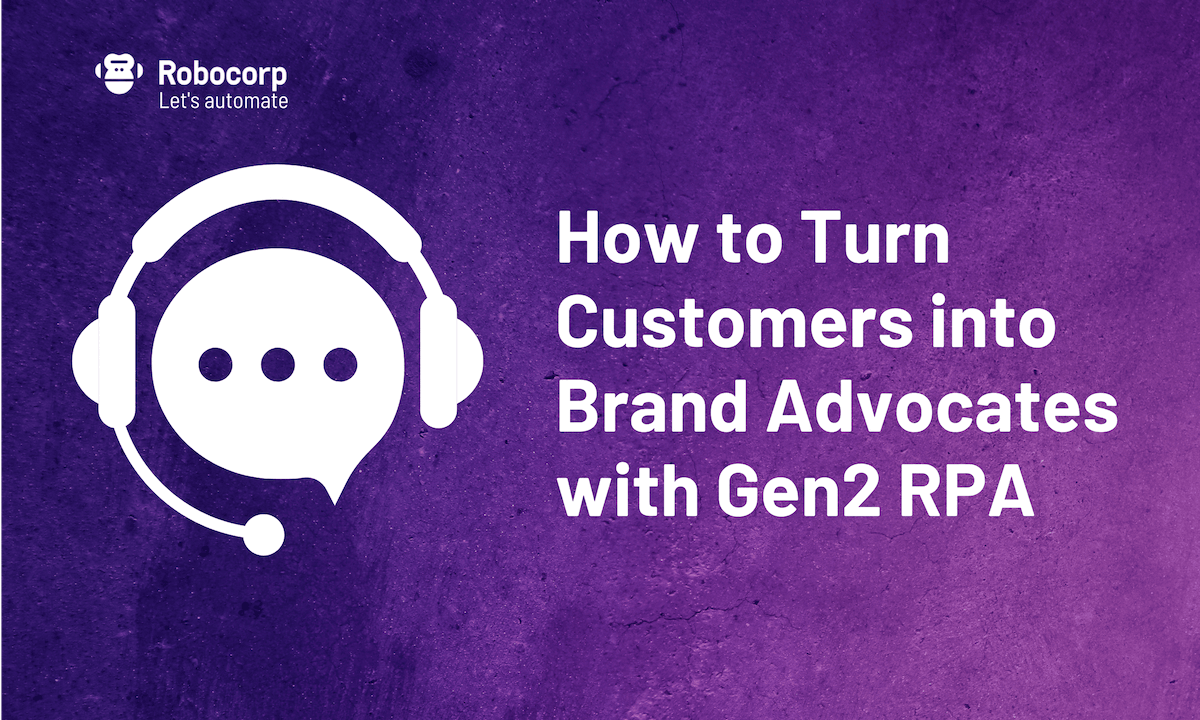
How to Turn Customers into Brand Advocates with Gen2 RPA
January 17, 2023 – Scott Eddleman, Head of Product Marketing, Robocorp
What does it mean to provide an excellent customer experience? How do you know when you've achieved it? And most importantly, how can you make sure your customers have the best possible experience every time they interact with your company? We’ll explore these questions in more detail.
What do customers want?
A recent customer experience survey conducted by Conduent revealed some interesting findings:
- High quality and consistency across every interaction channel top the list of customer wants.
- Meaningful interactions that evoke a feeling of happiness and resolve their needs quickly are key.
- Conversational customer experiences with humans via chat, text, email, and phone are preferred. Self-service and bots come in second but are still important.
It’s worth noting that customer preferences have changed dramatically over the last two years due to the pandemic. Customers now demand a more digitally holistic approach to communications that wasn’t as important in the past.
How do you gauge customer happiness?
Measuring customer satisfaction is essential for brands to understand how their customers feel about their products or services - and can be used to identify customer needs, improve customer experiences, and measure customer loyalty.
The most common way to calculate customer satisfaction is through net promoter scores (NPS) - which measure customer loyalty based on a customer's willingness to recommend the business or product to others. NPS is a simple, yet powerful tool that enables businesses to understand customer sentiment and identify opportunities for improvement.
By asking customers one fundamental question - “How likely are you to recommend our product/service to a friend or colleague?” - companies can quickly get an idea of customer loyalty and satisfaction. Customers answer on a 0-10 scale, with 10 being the most positive score and 0 being the least positive score. The customer responses are then grouped into three categories: promoters (scores 9-10), passives (scores 7-8), and detractors (scores 0-6).
By tracking customer satisfaction over time, brands can make adjustments that will lead to higher levels of customer retention and growth.
Which brands offer the best customer experiences?
A recent report published by Business Insider ranks the Top-100 best brands according to their customer NPS scores. Here’s a glimpse at the top 10:
- Peloton - Health and wellness
- Netflix - Media and entertainment
- Costco - Retail
- Chick-fil-A - Retail, food, and beverage
- Amazon - Global e-commerce
- Apple - Technology, consumer electronics
- Nike - Fashion and beauty
- Target - Retail
- Google - Technology, software, and hardware
- Spotify - Media and entertainment
What do these brands have in common? They all excel at building customer-centric organizations that drive loyalty and retention - and turn customers into brand advocates. They do this by balancing brand culture, training, customer insights, and well-coordinated technology.
Why do brands struggle with customer experience?
Most brands have an overabundance of data but underutilize it when supporting customers, according to the Conduent report. In fact, the majority of brands believe consolidating consumer data into a single source of truth across channels is very important - but only 16% have done so.
Shockingly, 98% of brands believe that customer satisfaction is a key indicator of loyalty, but barely 20% are measuring it well. Furthermore, 84% believe AI, analytics, and bots will drive hyper-personalized consumer interactions, yet only 8% are using such technology.
These findings point to one overarching conclusion - there is a tremendous amount of opportunity for brands to up their customer experience game - and drive transformational business results by connecting culture, training, and technology more tightly.
How does Gen2 RPA boost customer satisfaction?
Gen2 RPA is an advanced form of intelligent automation that connects all your technologies together and automates customer experiences across every channel. It’s able to interface with your legacy systems - including mainframes and homegrown platforms - and put that data to use with the rest of your technology stack.
Gen2 RPA can read and write data to your CRM, ERP, eCommerce site, mobile app, FAQs, call center scripts, chatbots, social media accounts, and internally-built applications. It then automates customer tasks by choreographing workflows and making decisions.
With access to such a wealth of data, brands are able to leverage user insights to pre-qualify customer inquiries, direct customers to relevant support articles, and provide intelligent self-service options. This drives up NPS scores by reducing wait times, improving accuracy, and increasing responsiveness without a major investment. You’ll reduce costs by automating routine inquiries and free up customer service agents to handle more complex issues.
Are you ready to raise your NPS score?

Make a plan to elevate your customers’ experiences. Pay attention to your KPIs and uncover gaps between insights and execution. Remember that your customers want instant solutions. They expect seamless omnichannel experiences - with real-time messaging at the forefront.
You may already have most of the technology needed to deliver world-class customer support - but you’ll need to make it communicate across systems - and intelligently automate workflow in the middle.
Gen2 RPA by Robocorp will enable you to gather valuable customer insights about your customers to empower your care agents, self-help tools, and chatbots with the right responses. Adding AI/ML tools to the mix will help you understand your customers better and respond more effectively.
Talk to a pro to learn how Gen2 RPA can boost your NPS scores and turn customers into brand advocates.